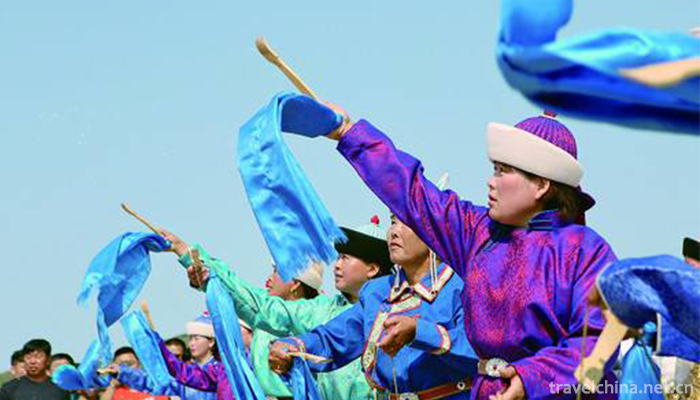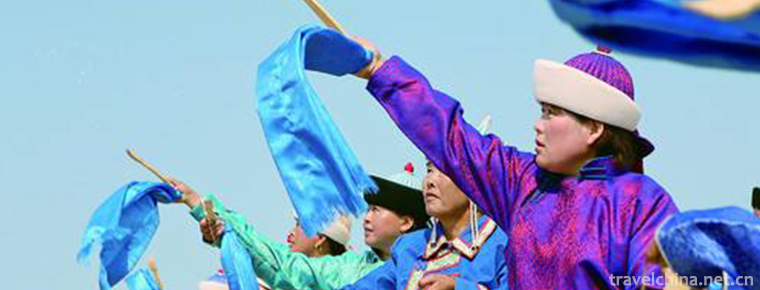Bogda Ula Festival
Bogda Ula Festival
The sacrifice of Bogdahura (Shenshan) is one of the earliest forms of Mongolian creative culture in China. It is the product of national culture, which is formed by historical accumulation and pluralism. It studies the special system of Mongolian folklore in a comprehensive and multidisciplinary way. The basic judgment is that sacrificial activities prevailed in Zalaite Banner during Tang, Song and Yuan Dynasties, especially after Shamanism was introduced into other places, and integrated with local customs to form a historical national cultural achievement. Although historical records are not fully recorded, historians believe that Zalai Banner was a historical national cultural achievement. The sacrifice to the God hill of Laite is another monument of Chinese folk culture. It can be seen from the origin of the sacrificial form of mountain names, the statues of God hills, the scriptures of God hills, the carols of God hills, the matching Nadamu congress, economic and trade exchanges and other relics. What a magnificent sacrifice to Bogdahura (god hill) was at that time! Its comprehensive Mongolian culture has a clear skeleton and a long history of inheritance. The sacrificial activities of Bogdahura (Shenshan) created by the Mongolian people have passed down from generation to generation in Zalaite, and become more and more solemn. The more formal the theme, the more three-dimensional development. However, because the sacrifice of Shenshan has been spread and presided over in Mongolian, there is no chance to translate into Chinese and English, so it has a serious closed impact at home and abroad. By the late 1950s, scholars and famous literary figures in Inner Mongolia, such as Jinfeng, Liu Yingman, Zhou Juxia and Liu Shaohua, publicly published the sacrifice of Shenshan in books and periodicals. In the 1960s, it aroused the attention of the leaders of Inner Mongolia Autonomous Region and people with lofty ideals from all walks of life. When Chairman Buch visited, he also came to Zalaite to mention the sacrifice of Shenshan, which aroused the attention of Comrade Bao Junchen, Vice-Chairman of the Political Consultative Conference of Inner Mongolia Autonomous Region. After that, the major TV stations recorded and broadcast the contents and procedures of the sacrifice of Shenshan from different perspectives, forming documentary prose and academic papers. Relevant materials such as "Environmental Protection Textbook" of Fang Party Course. A set of books and magazines on Bogda Ula (Shenshan) sacrificial culture will be published to recommend sacrificial activities, which will cause scholars at home and abroad to discuss Bogda Ula (Shenshan) sacrifice as a result of Mongolian and Yuan culture, and write a historical chapter with their own characteristics.
Zalaite Bogdahura (Shenshan) sacrifice has a long history, unique form, content and scriptures of Shenshan, and there are absolutely no mountain gods. In sacrificial activities, the time, place and preparation of sacrificial offerings are notified by the Yamen, and sacrificial offerings are held. The Lord sings the song "Ode to Ketuura in Uliji Chao" in Mongolian, invites the living Buddha to recite sutras, and then holds the Nadamu congress, trade material exchange and performing traditional Mongolian songs and dances, which are matched with the sacrificial offerings. It is said that the sacrifice of Bogdahura (Shenshan) is held from May 21 to May 23 of the lunar calendar every year, and the sacrificial activities are solemn and unique. Location: Bogda Ura Heimaurihada (Shenshan). 1. Pre-sacrificial preparation: First, the Qiyamen Damule (presided over) announces the date and place of sacrifice, accepts incense, food, wine and other personal apportionment items from each Nutuk; the task of Harule is to make a seven-day tour of the mountains, punished by hunters and fellers. 2. Scale: Each Nutuk arrives one day ahead of the sacrificial time and gathers at the south foot of Shenshan Mountain. In the center is the Mongolian yurt group of Qiwang Ye and his family, on the right is the Mongolian yurt group of Yamen officials and living Buddhas, doctors and businessmen, and on the left is the Mongolian yurt group of grass-roots officials and ordinary people in Konutuk. 3. Procedures, sacrificial offerings and other preparations: regularly carry Lama's drums, trumpets and other magic instruments and sacrificial offerings such as sheep and wine to designated sacrificial sites in Shenshan. 4. Decoration of Obo: Damuler's will, with decorations, began to decorate Obo in Black Maurihada, hanging picking banners or cloth strips around Obo, placing yellow cloth on a large strip of slate, placing dozens of bowls filled with water, wine and offerings, placing the rear feet of sheep and cattle, etc. In the south side of Obo, a white Jade statue of the Han Dynasty and several large-character banners of "Mountain God Sacrifice" were erected. 。 5. Lamas chant scriptures: In the past, the main character of Aobao was Lamas. After all the offerings were put on display, dozens of lamas sat in front of Aobao with cockcrown caps and robes. They recited the scriptures of God. When the big lamas waved Ling in their hands and lifted the macaroni in their other hands, bronze trumpets rang through the valley. 6. Pointing to the mountain gods: After the Lama recited the sutras, the Lord Master Mahbatu of Zazakh Belle took the lead in kneeling to Obo, and Master Ruben gave the pilgrims a motto ceremony, and waited for Adis to be accepted. 7. Giving Adis: Han means food cleansed by mana through Buddhist sutras. Several etiquette officers sprinkled manna around Obo. It was said that eating the Adis would bring good luck. 8. Convening the Obo Conference: The people who attended the sacrifices came down from the mountains and returned to the Mongolian yurts, and then began the Obo Conference. Presided over by Prince Marenshbatu of Zazakhstan, this paper mainly discussed the topic of how to protect the ecological environment of Shenshan and how to protect the sacrificial activities of Bogdahura (Shenshan). Punishment for deforestation of hunters. 9. Entertainment banquet: Damule and Harule add wine and meat to everyone. People sing and dance. Lamas perform Chama dances. Everyone sings the song "Ode to Uliji Chao Ketuura". The atmosphere was very warm and high. 10. Nadamu: It is the Mongolian horse racing, archery and wrestling matched with the sacrificial activities. 11. Bogdahura (Shenshan) sacrifice brings in traders from inside and outside the banner for trade exchanges, such as sheepskin, fungus, local products, cattle, sheep and other trading activities. To sum up, year after year, the inheritance and development of Mongolian cultural system, in addition to its own characteristics, promote national unity and improve the quality of the development of Zalaite harmonious society.


-
2.Huangpi Mulan Cultural Ecotourism Area
Wuhan Huangpi Mulan Cultural Eco-tourism Area is located in Huangpi District, Wuhan City, Hubei Province, including Mulan Mountain, Mulan Tianchi, Mulan Grassland
Time 2018-12-12 -
3.Langyatai Scenic Area
Langyatai Scenic Spot belongs to Qingdao Langyatai Provincial Tourism Resort (established in December 1995 with the approval of Shandong Provincial People's Government with a planned area of 9.8 squar
Time 2019-01-29 -
4.Yangtze River Source of Tuotuo River
Tuotuo River: Located in Tanggula Mountain Town, Southern Region of Golmud City, Qinghai Province, it is the West source of the Yangtze River, south of the Hoh Xili Mountains.
Time 2019-02-22 -
5.Changdian Temple
Changdian Temple Fair is a traditional folk custom and folk religious belief activity in Beijing. Among the many temple fairs in the old capital city, only the temple fairs in Changdian
Time 2019-04-16 -
6.Comba Rai
"Kangbalayi" is a poetic language of communication between Tibetan men and women in Zhiduo County. It originated in Songzan Period of Southern Japan in the end of the sixth century.
Time 2019-05-08 -
7.Yueqing Poplar Wood Carving
Yueqing boxwood carving, a kind of ornamental round carving art with boxwood as its material, is mainly popular in Houhengcun, Wengyuan Street and Lecheng Street of Liushi Town in Yueqing City,
Time 2019-05-11 -
8.Manufacturing Techniques of Fukushima Ship with Watertight Cabin
The manufacturing technology of watertight compartment Fukushima, the local traditional handicraft technology of Jiaocheng District in Jinjiang and Ningde City, Fujian Province, is one of the national
Time 2019-06-15 -
9.Production Techniques of Wufangzhai Zongzi
The traditional production techniques of Wufangzhai zongzi are mainly divided into 36 processes, such as material selection, rice dipping, leaf boiling, stuffing, shelling, wrapping, thread binding an
Time 2019-06-29 -
10.Xihua University
Xihua University, located in Chengdu City, Sichuan Province, is a provincial key comprehensive university with complete disciplines and multi-disciplinary development. It has been selected as "Ba
Time 2019-08-31 -
11.Capital Medical University
Capital Medical University (Capital Medical University), known as the first Medical University, is jointly established by the Beijing Municipal People's government, the national health and Health Comm
Time 2019-11-26 -
12.Wenshu Temple
Wenshu Temple is located in Qingyang District of Chengdu City. It was founded in the Daye period of Sui Dynasty (605-617). In 1697, the 36th year of Kangxi raised funds to rebuild the temple, which was renamed Wenshu courtyard.
Time 2020-10-18